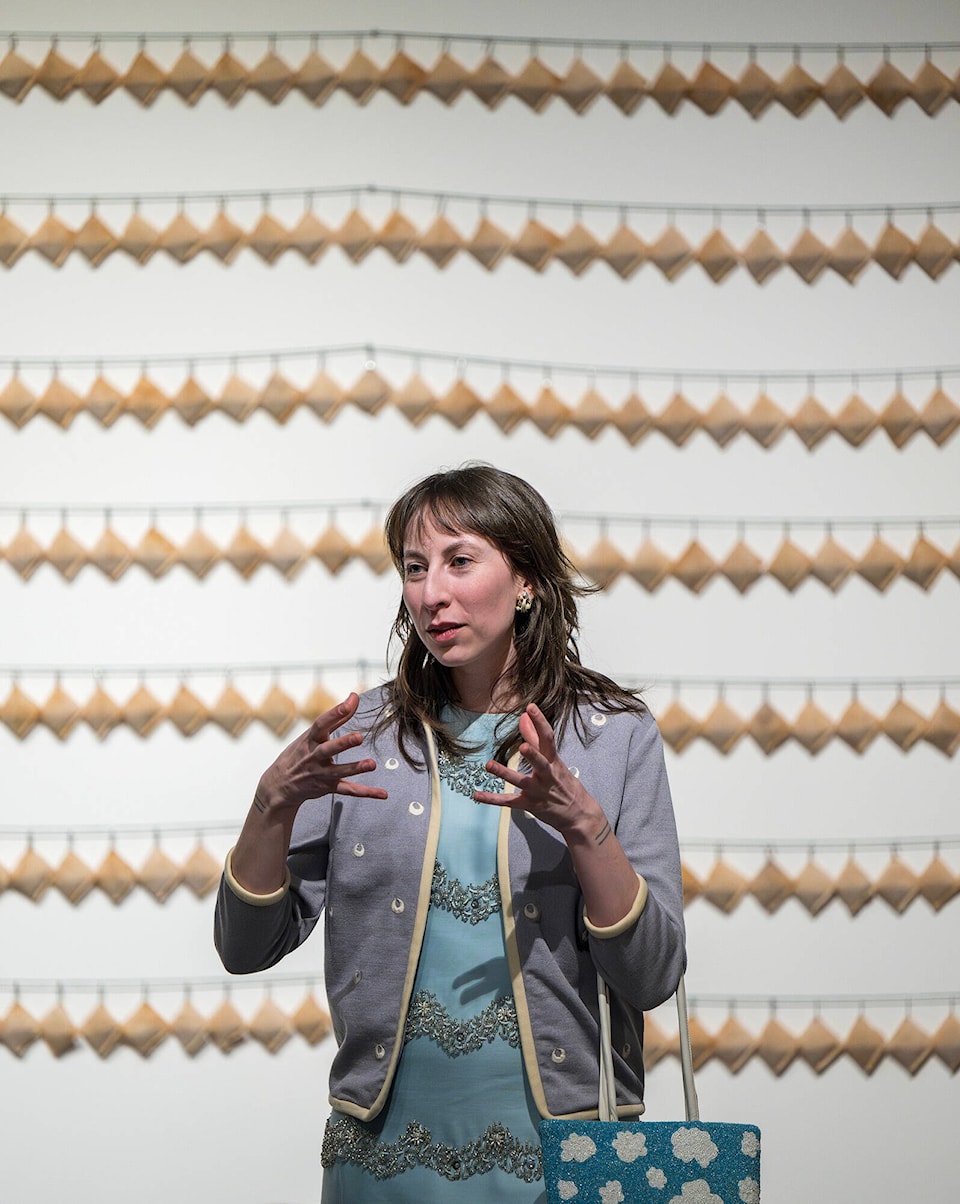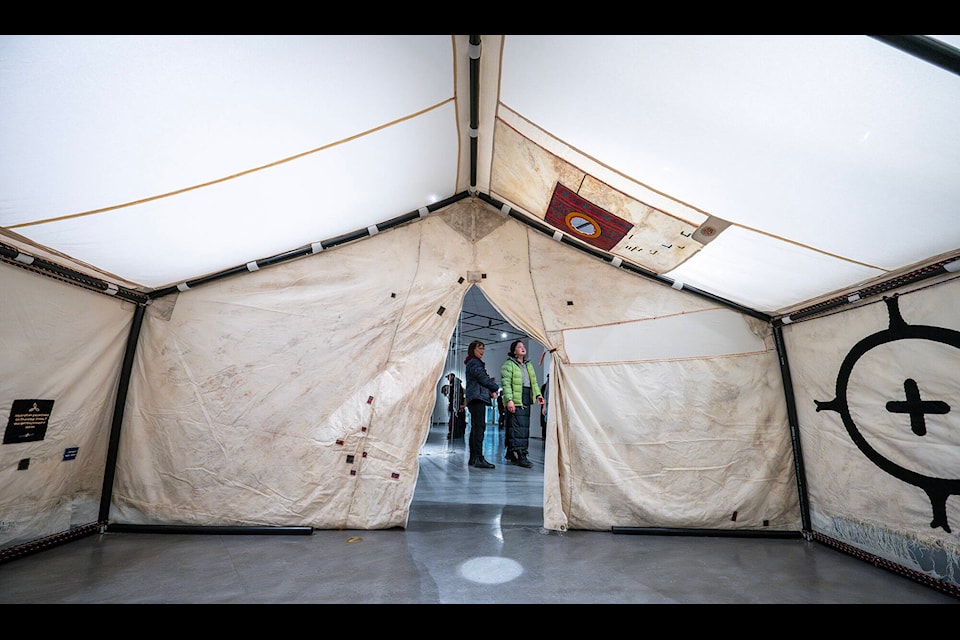Teresa Vander Meer-Chassé is inviting you, quite literally, into her grief when you visit her current exhibition at the Yukon Arts Centre (YAC).
The show is titled Shii’itsüh | Crying in the Heart, and consists of three installations. One of these is, from the outside, a classic white wall tent.
When you step inside though, it’s not filled with the things you’d expect — a bed, a woodstove, a glowing lantern — but with the memories of people Vander Meer-Chassé has lost in recent years.
The walls are stitched with text messages Vander Meer-Chassé, an Upper Tanana, Frisian, and French artist and curator, has recreated in beadwork. From a distance, they seem to be adornments.
It’s only when you get close enough to read them, that you feel the weight of the words and how the artist’s grief surrounds you.
“My brother passed away on Thursday. Please, if you get this message or call me.”
“I don’t want to lose you too.”
“Have you seen them lately?”
It’s jarring, and that was intentional, says Vander Meer-Chassé. When she was conceptualizing the piece, “Nee’ Shah | Our House,” she thought of how the wall tent is a symbol of home for many Yukoners who grew up in them in the bush, slept in them at fish camps or continue to take them out on hunts.
A wall tent invites you in with the promise of comfort, says Vander Meer-Chassé.
She wanted its interior to do the opposite: For her raw grief around the losses she’s still processing, to make you want to leave, even as you stay.
“I wanted to take (the comfort) all away because that’s the feeling of grief,” she said.
You go through cycles of remembering people, places and things, but it’s spotty. Not everything is there. And memories of loved ones, depending on where you are in those cycles, are similarly light or dark.

All three pieces in the exhibition were completed as part of Vander Meer-Chassé’s master’s degree in fine arts at Montreal’s Concordia University. The exhibition will remain in place at the Yukon Arts Centre until May 17.
Mary Bradshaw, director of visual arts at YAC, says the centre is thrilled to be able to show it for the first time in the Yukon.
“It’s exciting to have it here in the community,” says Bradshaw. “(Vander Meer-Chassé) has brought so much intent and thoughtfulness to each piece as it mediates on grief and remembrance. The audience has taken time to move through the space, really taking it all in.”
And they’ve left behind some memories of their own in the gallery guest book.
Comments there call the work beautiful, thoughtful and evocative.
“Gave me chills. Really powerful,” says one comment.
“So much care and depth,” reads another.
Some of the memories Vander Meer-Chassé works through within the walls of “Nee’ Shah,” are those of her brother, Stewart Chassé, who died following substance use disorder.
She wanted to express her frustration with the way he died, which she knows is a feeling shared by many, but she wanted to avoid anything graphic, that might limit the focus only to substance use.
Rather, she wanted to highlight her own perspective as someone who loved her brother, and who continues to care and hope for the people in her life who have used, or continue to use substances.
“Nee’ Shah” also makes her think of her grandma, Marilyn John, who worked on the piece with Vander Meer-Chassé, and who was supposed to be at the show’s opening in February.
“She named the piece,” said Vander Meer-Chassé.
She says her grandma taught her to do beadwork when she was just eight, though John herself didn’t like beading or sewing.
“She felt it was a role women in Upper Tanana communities played, so in that way she kind of picked it up again, but I know she didn’t get as much enjoyment from it as I did. She was very much a hunter.
“She’d rather go out and get a beaver or a moose by herself than sit at home and bead.”
The last time Vander Meer-Chassé showed the piece, in Montreal in 2023, her grandma was still alive.
Now, with John gone, the piece takes on a different tone for her. It was never meant to be about the loss of John specifically, but now it can’t help but feel to Vander Meer-Chassé as though the tent is grief in progress.
It’s a contrast to the two other installations in the show, a wall strung with hundreds of tea bags, and a garment, both of which are about her Oma, who died when Vander Meer-Chassé was roughly 12. Both pieces are more brightly lit than “Nee’ Shah.” That was also intentional.
To Vander Meer-Chassé, it doesn’t suggest that she’s not still mourning her Oma, but that she’s processed enough of her feelings to be able to look back on the good memories.
Altogether, the show is a very personal story about grief, she says. At the same time, it couldn’t have happened without community.
She and her dad paddled out to the family’s wall tent and dragged it out of the bush so she could use it for the piece, which was part of her master’s thesis at Concordia University.
The fish skins in the tent were tanned by Vander Meer-Chassé, her god-daughter, aunt, mom and late grandma. The seeds that hang on one of the tent walls were collected when her grandpa took Vander Meer-Chassé and her mom to collect silverberries.
“It’s a good reminder that sometimes we sit in loneliness with grief,” she said.
“But it’s always the support of family and friends that gets you through.”
